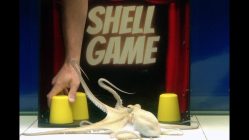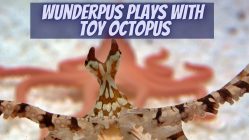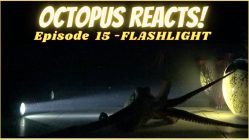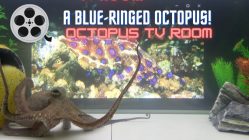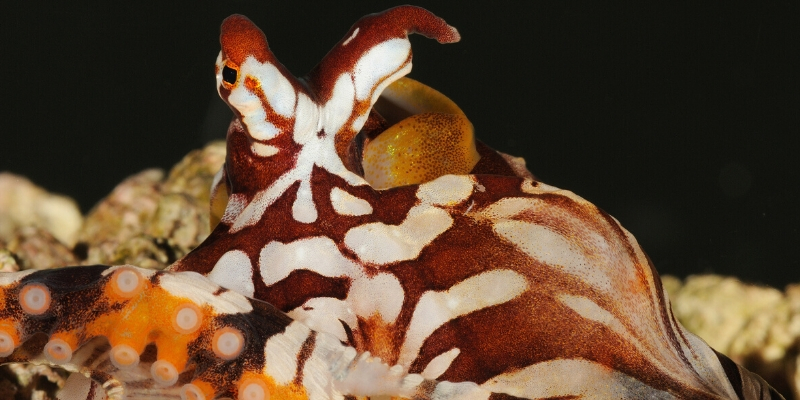
Although the existence of the Wunderpus Octopus has been reported since the mid 1980’s, this new species has been officially described by scientists only as recently as in 2006. The Wunderpus Photogenicus, more commonly referred to as the Wunderpus or Wonderpus Octopus, has been thus named to refer to its wonderful, long arms (from the German word “wunder” which translates as miracle or wonder, and the Ancient Greek word “pus” meaning foot) as well as to the fact that it has been, and still is to this day, a very attractive subject for photographers.
The discovery of this new species was the unsurprising outcome of diving gaining more popularity as a hobby along with the improvement of underwater photography thanks to technological advances. However, in order to formally recognize the new species enough specimens needed to be collected, a task which proved difficult for scientists. The Wunderpus Octopus is still considered a rare species.
Thanks to its photogenic nature, the Wunderpus has become a somewhat tourist attraction, making it a commercially important species for diving destinations, especially in Indonesia close to the famous diving region around the Lembeh Strait.
Wunderpus Octopus Facts
- Scientific Name : Wunderpus Photogenicus
- Common Name: Wunderpus Octopus
- Size: 23 cm
- Weight: 26 g.
- Lifespan: Unknown
- Found in: Indo-Malayan Archipelago
- Sub-Order: Incirrina
- Discovered: mid 1980s
- Scientific Name : Wunderpus Photogenicus
- Common Name: Wunderpus Octopus
- Size: 23 cm
- Weight: 26 g.
- Lifespan: Unknown
- Found in: Indo-Malayan Archipelago
- Sub-Order: Incirrina
- Discovered: mid 1980s
The Wunderpus Photogenicus, more commonly referred to as the Wunderpus or Wonderpus Octopus has been, and still is to this day, a very attractive subject for photographers.
—Distribution—
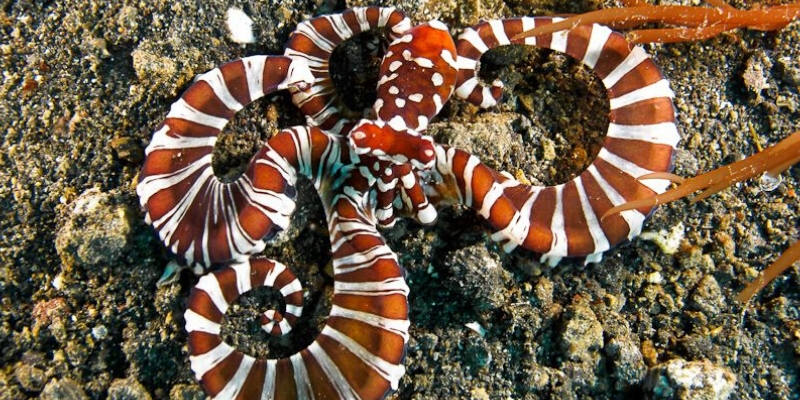
The Wunderpus Octopus occurs in shallow, tropical waters. Individuals have been collected at a depth range from 0.5 to at least 20 meters (66 feet).
It can be found from Bali and Sulawesi north to the Philippines and east to Vanuatu.
—The Wonderful Looks of the Wonderpus—
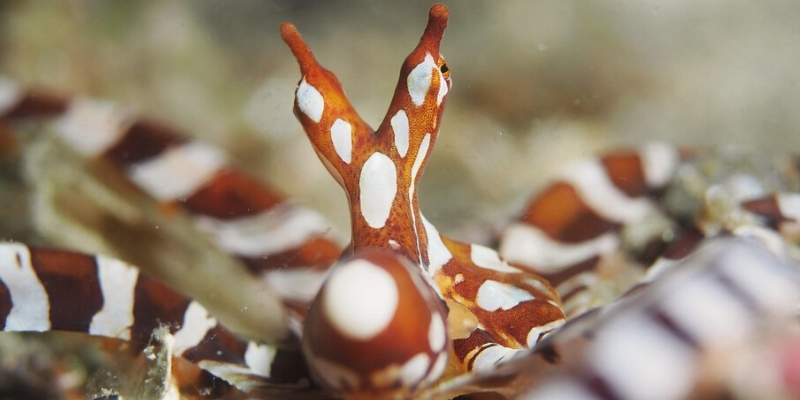
In terms of size, the Wonderpus is a small, delicate-looking octopus.
As mentioned above, the Wunderpus Octopus has beautiful, long, thin arms, which are about five to seven times the length of its mantle. The suckers on each arm are widely spaced and unlike most octopus species, the male Wonderpus Octopus is not characterized by the presence of enlarged suckers.
The Y-shaped head, together with the small eyes on the elongated stalks that are often raised, and the conical papilla above each eye, give an entirely alien, and comically inquisitive look to this species.
Its color is brown to red, with distinct white stripes along its arms and white spots and bars along its mantle, head, and eye stalks.
Unlike most octopus species, the Wunderpus Octopus does not change its body pattern but only alters its hue and contrast.
For scientists, probably the most interesting part about the Wunderpus physical appearance is that the spots on its head are unique to each individual. Being able to recognize and identify specific individuals opens up new horizons to exploring the behavioral patterns and social interactions of the octopus.
—Male or Female?—
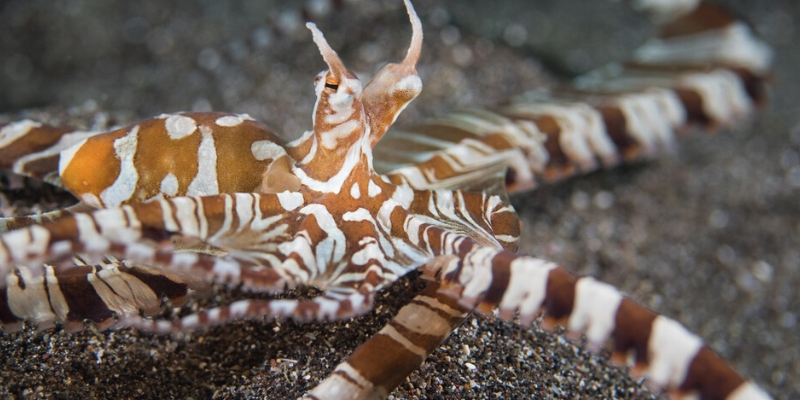
Since there are no enlarged suckers, how can the male Wunderpus Octopus be distinguished by the female?
First of all, the female’s mantle is wider than her head, since it houses her large ovary. The male Wunderpus’ head, on the other hand, is wider than his mantle.
Moreover, the male’s specialized reproduction hand, the hectocotylus, is much shorter, less than 1/3 length of his opposite arm. Due to the short length of the hectocotylus, the male Wunderpus Octopus will mount the female in order to mate rather than inserting the hectocotylus from a safe distance, as other species usually do.
The female Wunderpus Octopus can produce around 2,000 small eggs, which, when matured, are around 2.9–3.6 mm long. Similar to the Blue-ringed Octopus, the female will carry her eggs underneath her arms, instead of choosing a safe spot to lay and brood them.
—Are You Hungry? Here is an Arm!—
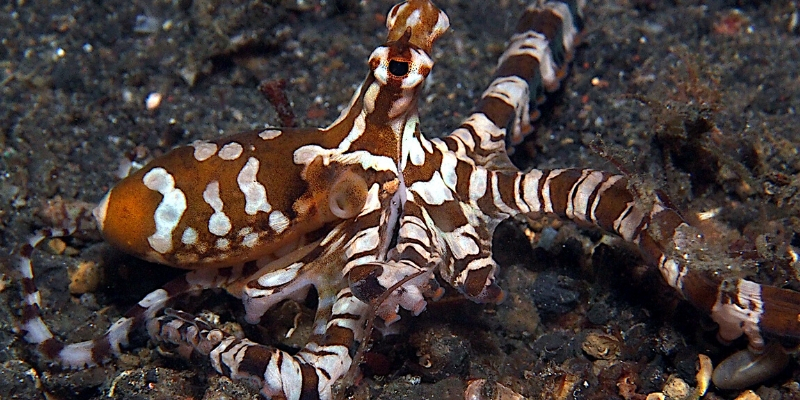
Scientists have found a lot of specimens with missing arms. This is not unusual for octopuses as they face many dangerous predators and do not always escape their attackers intact.
However, scientists observed that the missing arms of Wunderpus Octopuses were all severed at the same length. This led them to speculate that the Wunderpus Octopus is capable of self-amputating an arm if needed. If, for example, they happen to come across an enemy which is simply too powerful to mess with, the Wunderpus Octopus prefers to offer an arm as decoy while it manages to escape. After all, regeneration is quite easy if you are an octopus but resurrection is impossible, even for an octopus!
—Mimic or Wunderpus?—
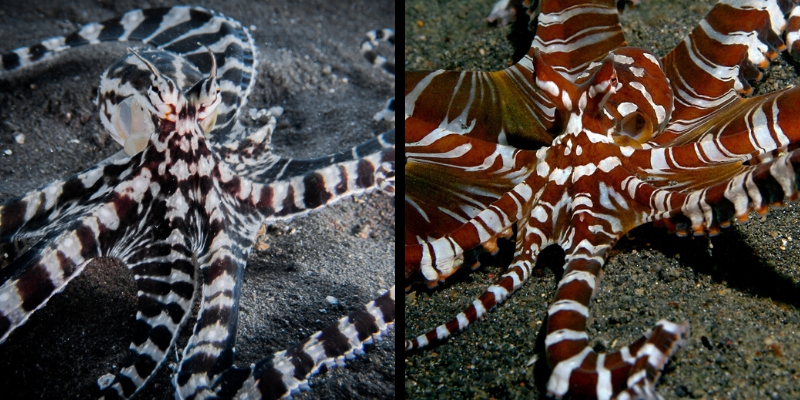
The Wunderpus Octopus is frequently confused with another similarly-looking species, the Mimic Octopus.
However these two species can be easily distinguished, not only based on their appearance but also based on their behavior. For example, whereas the Mimic Octopus usually hunts during the day, the Wunderpus Octopus exhibits a crepuscular activity pattern, mainly hunting during the hours of dusk and dawn.
As far as their physical looks are concerned, the Wunderpus Octopus’ markings on its mantle have clear edges, its eyes are supported on a longer stalk and the bright white line along the suckers, present in the Mimic Octopus, is absent in the Wunderpus Octopus.
Being close relatives makes them no less aggressive towards each other. Scientists have witnessed one Mimic Octopus and one Wunderpus Octopus fighting over a snack. The Wunderpus Octopus, in fact, managed to defeat the Mimic Octopus, by forming a loop around the mantle with its arm and asphyxiating it.
Like the Mimic Octopus, the Wonderpus is also known to impersonate other poisonous animals, such as the scorpaenid lionfish or the banded sea snake.
—Everyone Wants a Wunderpus at Home—

The Wonderpus is so wonderful, no wonder why all aquarium owners would love to have one at home.
This species is highly valued for its ornamental quality and it is therefore fairly expensive. Supplies argue that the demand is high, and the Wunderpus Octopus hard to come by, rising its price to even above $700.
If you are a beginner, it is probably not the best idea to adopt a Wunderpus Octopus. First of all, there is a theory that the intense color of the Wunderpus might indicate that it is, in fact, poisonous.
Not a lot is known about the Wunderpus Octopus in general. Much less is known about their life in an aquarium. They are supposed to do bad in captivity, but maybe this is only because suppliers provide mature individuals which are towards the end of their life.
All in all, although the Wonderpus is certainly wonderful, it is not recommended as a pet octopus choice.





